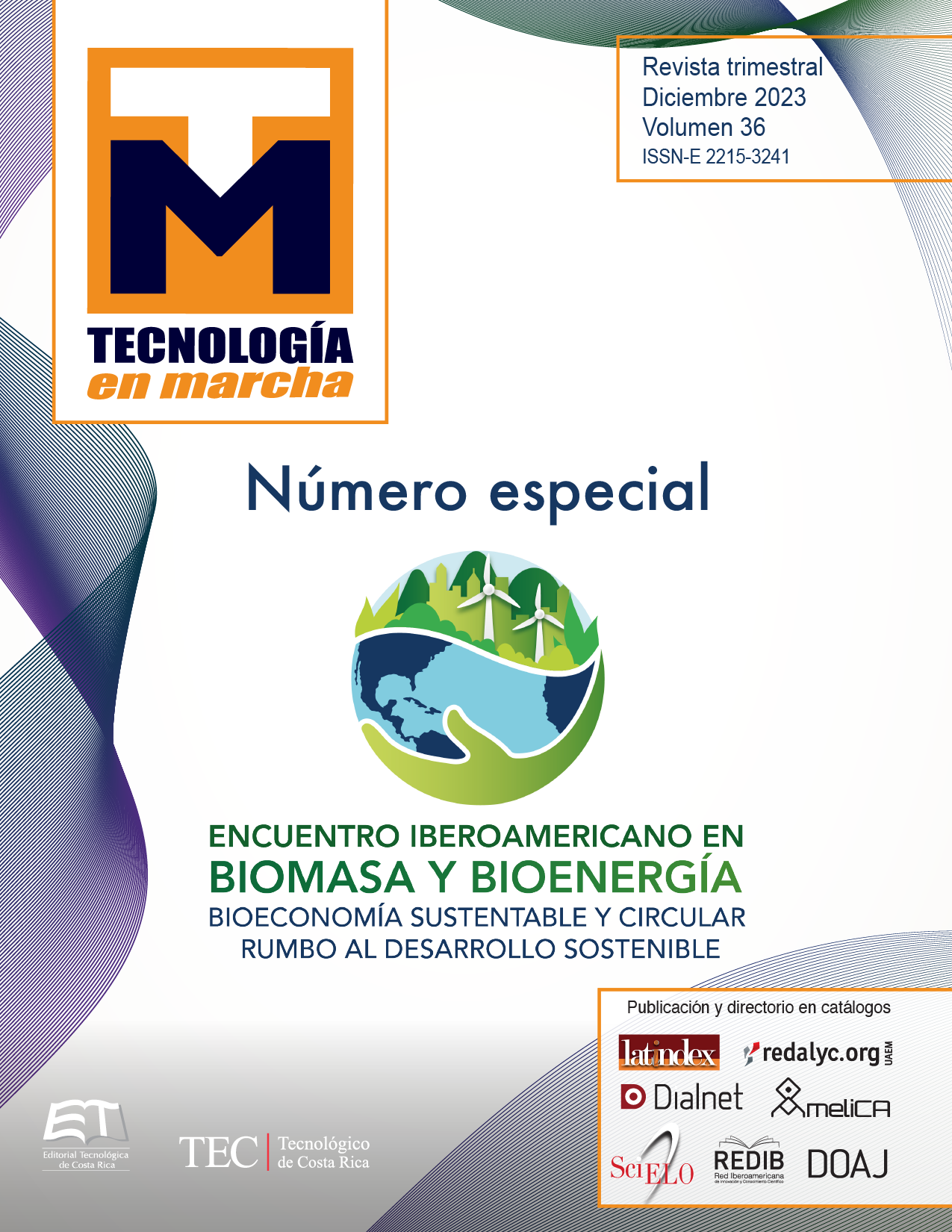Eugenol hydrodeoxygenation employing bifunctional Ni-Pd and Ni-Pt catalysts on zirconium pillared clays
Main Article Content
Abstract
This work evaluated bifunctional mono and bimetallic catalysts of Ni, Pd, and Pt using total metallic loading lesser than 3% wt. percent supported on pillared clays modified with zirconium cations in the hydrodeoxygenation reaction of eugenol at medium pressure conditions and temperature, 3 MPa, and 573 K, respectively. The catalysts were texturally and structurally characterized by means of N2 physisorption and X-ray diffraction. The impregnation of the metallic phases was carried out through the solid-state impregnation method. The monometallic catalyst that presented the highest activity was that of Pd, k= 4.94 x10-2 min-1; a conversion of 99.98% was reached at 75 min of reaction and selectivities to 4-propylphenol and propyl-cyclohexane, 22 and 29 % molar, respectively. In the case of bimetallic catalysts, the most active was 1Ni1Pd, k= 3.83 x10-2 min-1, reaching a conversion of 99.6% at 105 min and selectivities to 4-propylphenol and propyl-cyclohexane, 14 and 31% molar, respectively; derivated of demethoxylation and hydrodeoxygenation reactions. Furthermore, it was found that the H/C molar ratio using the 1Pt catalyst was equal to 1.93, close to that found in commercial jet fuels (1.98) or even higher than that of aviation biofuels reported in the literature (1.37).
Article Details

This work is licensed under a Creative Commons Attribution-NonCommercial-NoDerivatives 4.0 International License.
Los autores conservan los derechos de autor y ceden a la revista el derecho de la primera publicación y pueda editarlo, reproducirlo, distribuirlo, exhibirlo y comunicarlo en el país y en el extranjero mediante medios impresos y electrónicos. Asimismo, asumen el compromiso sobre cualquier litigio o reclamación relacionada con derechos de propiedad intelectual, exonerando de responsabilidad a la Editorial Tecnológica de Costa Rica. Además, se establece que los autores pueden realizar otros acuerdos contractuales independientes y adicionales para la distribución no exclusiva de la versión del artículo publicado en esta revista (p. ej., incluirlo en un repositorio institucional o publicarlo en un libro) siempre que indiquen claramente que el trabajo se publicó por primera vez en esta revista.
References
C. Kordulisa et al. “Development of nickel-based catalysts for the transformation of natural triglycerides and related compounds into green diesel: a critical review”, Applied Catalysis B: Environmental, 181,156–196, 2016. https://doi.org/10.1016/j.apcatb.2015.07.042
A. Kumar et al. “Alternative biomass from saline and semiarid and arid conditions as a source of biofuels: Salicornia”, Biofuels: Greenhouse Gas Mitigation and Global Warming: Next Generation Biofuels and Role of Biotechnology, 229–240, 2018. Springer India. https://doi.org/10.1007/978-81-322-3763-1_13
A. Sullivan et al. “Thermal decomposition and combustion chemistry of cellulosic biomass”. Atmospheric Environment, 47, 133–141, 2012. https://doi.org/10.1016/j.atmosenv.2011.11.022
A. Bjelić et al. “Bifunctional metallic-acidic mechanisms of hydrodeoxygenation of eugenol as lignin model compound over supported Cu, Ni, Pd, Pt, Rh and Ru catalyst materials”. Chemical Engineering Journal, 394, 2020. https://doi.org/10.1016/j.cej.2020.124914
X. Li et al. “The relationship between acidity, dispersion of nickel, and performance of Ni/Al-SBA-15 catalyst on eugenol hydrodeoxygenation”. Renewable Energy, 149, 609–616, 2020. https://doi.org/10.1016/j.renene.2019.12.094
M. Martinez-Klimov et al. “Bifunctional Pt−Re Catalysts in Hydrodeoxygenation of Isoeugenol as a Model Compound for Renewable Jet Fuel Production” ACS Eng. Au, 2, 436−449, 2022. https://doi.org/10.1021/acsengineeringau.2c00015
V. K. Soni et al. “Ni/Co-Natural Clay as Green Catalysts for Microalgae Oil to Diesel-Grade Hydrocarbons Conversion”. ACS Sustainable Chemistry & Engineering, 5 (6), 5351-5359, 47, 967–981, 2017. https://doi.org/10.1021/acssuschemeng.7b00659
I. B. Adilina et al. “Hydrodeoxygenation of Guaiacol as a Bio-Oil Model Compound over Pillared Clay-Supported Nickel−Molybdenum” Catalysts. J. Phys. Chem. C, 123, 35, 21429-21439, 2019. https://doi.org/10.1021/acs.jpcc.9b01890
J.A. Colín et al. “Pillar effects in MoS2 catalysts supported on Al and Zr pillared clays in a hydrotreatmentreaction, apreliminary study”. Apliled Surface Science. Vol 240, 1-4, 48-62, 2005. https://doi.org/10.1016/j.apsusc.2004.05.296
Y. Zhu et al. “Optimization of reaction variables and macrokinetics for the hydrodeoxygenation of full range low temperature coal tar” Reaction Kinectics, Mechanisms and Catalysis 116:433-450, 2015. https://doi.org/10.1007/s11144-015-0900-x
P. Lahijani et al. “Upgrading biomass-derived pyrolysis bio-oil to bio-jet fuel through catalytic cracking and hydrodeoxygenation: A review of recent progress” Energy Conversion and Management 286, 115956, 2022. https://doi.org/10.1016/j.enconman.2022.115956
J. Wang et al. “Preparation of jet fuel range hydrocarbons by catalytic transformation of bio-oil derived from fast pyrolysis of straw stalk”, Energy 86, 488-499, 2015. https://doi.org/10.1016/j.energy.2015.04.053

